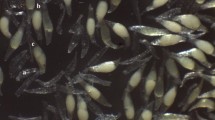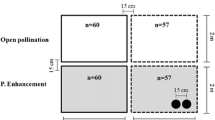Abstract
Resource and pollen limitation, as well as pollen/ovule incompatibility, have been proposed as causes to explain fruit abortion. To assess whether abortion in Opuntia microdasys was due to resource and/or pollen limitation and could therefore be reversed fruit set and seed set were studied using controlled pollination experiments on 60 plants that had been randomly assigned a combination of watering and fertilization treatments. On the other hand, to test whether fruit abortion was irreversible, due to pollen/ovule incompatibility, we examined the reproductive biology of the species. This included observations on floral phenology, nectar production, flower visitors, numbers of pollen grains and ovules, and self-pollination experiments. Results showed that O. microdasys is a fully self-incompatible species and its floral biology and the activity of the main pollinator allow constant deposition of incompatible pollen onto stigmas, which may contribute to fruit abortion. Reproductive success was limited by nutrients and pollen, but the fruit set increased only by 58%, compared to 47% of the control, after the experimental addition of pollen, nutrients and water. The magnitude of pollen and resource limitation suggests that similar levels of abortion will be present in good as well as in bad years. Selfing as well as incompatibility between ramets from the same clone and between closely related plants seem plausible candidates to explain the large proportion of fruit abortion, and experimental cross pollination between genotypes identified through molecular markers are necessary to fully understand the considerable abortion rate that remains unexplained after pollen and resource addition. Interestingly, the possible reason why the abortion of energetically expensive fruits has not been eliminated by natural selection is that the aborted fruits are propagules able to root and produce new plants with the same genotype of the mother. Abortion would have a dramatic effect on cross-fertilized genotypes because they result in zero fitness, but it would have a positive effect on the fitness of the maternal genotype because a clonal offspring is produced. Evidently, the exact fitness consequences to the maternal plant will depend on the differences in survival and reproduction of these different offspring types.

Similar content being viewed by others
References
Anthony M (1954) Ecology of the opuntiae in the big bend region of Texas. Ecology 35:334–347
Boyle TH (1997) The genetics of self-incompatibility in the genus Schlumbergera (Cactaceae). J Hered 88:209–214
Boyle TH, Menalled FD, O’leary MC (1994) The occurrence and physiological breakdown of self-incompatibility in Easter cactus. J Am Soc Hortic Sci 119:1060–1067
Bravo-Hollis H (1978) Las cactáceas de México. Universidad Nacional Autónoma de México, México, D.F
Broyles SB, Wyatt R (1993) The consequences of self-pollination in Asclepias exaltata, a self-incompatible milkweed. Am J Bot 80:41–44
Burd M (1994) Bateman’s Principle and plant reproduction: the role of pollen limitation in fruit and seed set. Bot Rev 60:83–139
Buxbaum F (1955) Morphology of cacti. Section III. Fruits and seeds. Abbey Garden Press, Pasadena, California
Campbell DR (1989) Inflorescence size: test of the male function hypothesis. Am J Bot 76:730–738
Campbell DR, Halama KJ (1993) Resource and pollen limitations to lifetime seed production in a natural plant population. Ecology 74:1043–1051
Casper BB, La Pine TR (1984) Changes in corolla color and other floral characteristics in Cryptantha humilis (Boraginaceae): cues to discourage pollinators? Evolution 38:128–141
Charlesworth D, Charlesworth B (1987) Inbreeding depression and its evolutionary consequences. Ann Rev Ecol Syst 18:237–268
Cruden RW (1977) Pollen-ovules ratios: a conservative indicator of breeding systems in flowering plants. Evolution 31:32–46
de Nettancourt D (1997) Incompatibility in angiosperms. Sex Plant Reprod 10:185–199
Franco AC, Nobel PS (1989) Effect of the nurse plant on the microhabitat and growth of cacti. J Ecol 77:870–886
Frankel R, Galun E (1977) Pollination mechanisms, reproduction and plant breeding. Springer-Verlag, New York
Good-Avila SR, Stephenson AG (2003) Parental effects in a partially self-incompatible herb Campanula rapunculoides L. (Campanulaceae): Influence of variation in the strength of self-incompatibility on seed set and progeny performance. Am Nat 161:615–630
Guitian J (1994) Selective fruit abortion in Prunus mahaleb (Rosaceae). Am J Bot 81:1555–1558
Herrera CM (1991) Dissecting factors responsible for individual variation in plant fecundity. Ecology 72:1436–1448
Juenger T, Bergelson J (1997) Pollen and resource limitation of compensation to herbivory in scarlet gilia, Ipomopsis aggregata. Ecology 78:1684–1695
Kearns CA, Inouye DW (1993) Techniques for pollination biologists. University of Colorado Press, Niwot, Colorado
Lee TD, Bazzaz FA (1982) Regulation of fruit and seed production in an annual legume, Cassia fasciculata. Ecology 63:1363–1373
Mandujano MC, Montaña C, Eguiarte LE (1996) Reproductive ecology and inbreeding depression in Opuntia rastrera (Cactaceae) in the Chihuahuan desert: why are sexually derived recruitments so rare? Am J Bot 83:63–70
McCall C, Primack RB (1987) Resources limit the fecundity of three woodland herbs. Oecologia 71:431–435
Melser C, Klinkhamer PGL (2001) Selective seed abortion increases offspring survival in Cynoglossum officinale (Boraginaceae). Am J Bot 88:1033–1040
Montaña C (1990) A floristic-structural gradient related to land forms in the southern Chihuahuan desert. J Veg Sci 1:669–674
Negrón-Ortiz V (1998) Reproductive biology of a rare cactus, Opuntia spinosissima (Cactaceae), in the Florida keys: why is seed set very low? Sex Plant Reprod 11:208–212
Palleiro N, Mandujano MC, Golubov J. 2006. Aborted fruits of Opuntia microdasys (Cactaceae): insurance against reproductive failure. Am J Bot 93:505–511
Parker KC (1987) Seedcrop characteristics and minimum reproductive size of organ pipe cactus (Stenocereus thurberi) in southern Arizona. Madroño 34:294–303
Pimienta-Barrios E (1990) El nopal tunero. Universidad de Guadalajara, Guadalajara, México
Pinkava DJ, McGill LA, Reeves T (1977) Chromosome numbers in some cacti of western North America-III. Bull Torrey Bot Club 104:105–110
Potvin C, Lechowicz MJ, Tardif S (1990) The statistical analysis of ecophysiological response curves obtained from experiments involving repeated measures. Ecology 71:1389–1400
Ramsey M (1995) Ovule pre-emption and pollen limitation in a self-fertile perennial herb (Blandfordia grandiflora, Liliaceae). Oecologia 103:101–108
Ramsey M, Vaughton G (2000) Pollen quality limits seed set in Burchardia umbellata (Cholchicaceae). Am J Bot 87:845–852
SAS Institute (1995) JMP statistics and graphics guide. SAS Institute Inc, Cary, North Caroline
Statsoft, Inc (1993) Statistica 4.3 for windows. Statsoft, Inc., Tulsa, Oklahoma
Stephenson AG (1981) Flower and fruit abortion: proximate causes and ultimate function. Ann Rev Ecol Syst 12:253–281
von Ende CN (2001) Repeated-measures analysis: growth and other time-dependent measures. In: Scheiner SM, Gurevitch J (eds) Design and analysis of ecological experiments. Chapman and Hall, New York
Weiss J, Nerd A, Mizrahi Y (1994) Flowering and pollination requirements in Cereus peruvianus cultivated in Israel. Israel J Plant Sci 42:149–158
Wiens D, Calvin CL, Wilson CA et al (1987) Reproductive success, spontaneous embryo abortion, and genetic load in flowering plants. Oecologia 71:501–509
Acknowledgments
We are grateful for the logistical support received from the staff of the Desert Laboratory INECOL, and for the assistance with fieldwork provided by K. Herrera, G. Muro, J. Sánchez, O. Montenegro and R. Lara. M. Franco and V. Sosa-Fernández made useful suggestions on the manuscript, Bianca Delfosse translated an earlier version of this article from Spanish. This study is part of the doctoral studies of HHP at the Instituto de Ecología, A.C. This research was funded by CONACYT project 4126P-N9608 awarded to CM. The participation of MCM was funded by project PAPIIT-DGAPA-UNAM IN205500, awarded to MCM. The participation of HP was funded by a graduate scholarship awarded by CONACYT.
Author information
Authors and Affiliations
Corresponding author
Rights and permissions
About this article
Cite this article
Piña, H.H., Montaña, C. & Mandujano, M. Fruit abortion in the Chihuahuan-Desert endemic cactus Opuntia microdasys . Plant Ecol 193, 305–313 (2007). https://doi.org/10.1007/s11258-007-9269-x
Received:
Accepted:
Published:
Issue Date:
DOI: https://doi.org/10.1007/s11258-007-9269-x




